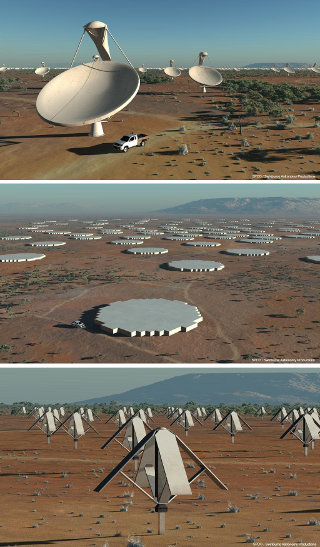
Images of the three SKA receptor types:- dishes, dense aperture arrays and sparse aperture arrays. Credit: SPDO / Swinburne Astronomy Productions.
Square Kilometre Array (SKA) telescope strengthens team with two new positions
11 May 2010
The SKA Program Development Office (SPDO) today announced the appointment of Mr Kobus Cloete to the role of Project Manager and Dr Minh Huynh to the role of Deputy International SKA Project Scientist. The appointments are made at a crucial stage in the finalisation of the design for the world’s largest radio telescope.
Kobus will lead the growing international SKA development team and coordinate work on the technical design of the telescope. He gained extensive experience working in the defence industry in South Africa before joining the South African MeerKAT radio astronomy project as Engineering Project Manager. He moved to the SPDO in 2008 as System Engineer for the PrepSKA phase of the SKA project and will assume his new role immediately. Commenting on his appointment, Kobus said:
I am very much looking forward to building on the strengths of the SKA project team and tackling the challenges of this ambitious and hugely exciting international project.
Minh will work with Dr. Joseph Lazio, the International SKA Project Scientist, along with scientists and engineers world-wide to further develop the pioneering science case for the SKA. Minh has experience with several international telescopes, including NASA's Spitzer Space Telescope and CSIRO's Australia Telescope Compact Array, and has been a leading member of international teams working on projects such as the Planck mission. The appointment, which starts on 1st October 2010, will be based at ICRAR in Australia with extended periods spent at the SPDO in the UK. Speaking about her appointment, Minh commented:
Balancing the aspirations of the astronomy community with the engineering design of the telescope will become increasingly important as the project grows, particularly during the development of cost models.
Richard Schilizzi, Director of the SKA, added:
As the SKA telescope moves from concept to reality, these two critical appointments bring not only world-class technical ability but also highly relevant scientific and engineering experience to the SPDO. I look forward to working with both Kobus and Minh as the SKA enters the next stage of development.
The SKA will be the most sensitive radio telescope on Earth, with the fastest survey speed. It will be capable of answering some of the most exciting and fundamental questions about the Universe. The SPDO is based at the Jodrell Bank Centre for Astrophysics at the University of Manchester.
-ENDS-
About the SKA
The Square Kilometre Array will be a revolutionary international radio telescope for the 21st Century. The total collecting area will be approximately one square kilometre giving 50 times the sensitivity, and 10,000 times the survey speed, of the best current-day telescopes. With receptors extending out to distances of 3,000 km from the centre of the telescope, the SKA will address fundamental unanswered questions about our Universe including how the first stars and galaxies formed after the Big Bang, how galaxies have evolved since then, the role of magnetism in the cosmos, the nature of gravity, and the search for life beyond Earth. More than 70 institutes in 20 countries, together with industry partners, are participating in the scientific and technical design of the SKA telescope which will be located in either Australia – New Zealand or Southern Africa extending to the Indian Ocean Islands. The target construction cost is €1,500 million and construction could start as early as 2016.
For more information and high res images contact:
Jo Bowler, Outreach Officer, SKA Program Development Office, UK.
Tel: +44 (0)161 275 4130. E-mail: bowler@skatelescope.org
www.skatelescope.org
About ICRAR
The International Centre for Radio Astronomy Research (ICRAR) is a State funded centre established as a joint venture between The University of Western Australia and Curtin University of Technology. The centre, based in Perth, is a participant in the international Square Kilometre Array (SKA) effort led by the SKA Program Development Office (SPDO).
For more information contact:
Pete Wheeler, Outreach and Education Manager, ICRAR, Australia.
Tel: +61 8 6488 7758. Email: Pete.Wheeler@icrar.org
www.icrar.org
About the Jodrell Bank Centre for Astrophysics (JBCA)
JBCA is the astronomical research centre of the University of Manchester and a world leader in radio astronomy-related research and technology development. The JBCA research programme includes multi-wavelength observations and theoretical work addressing topics ranging from extrasolar planets to the Big Bang. JBCA hosts the Program Development Office of the SKA, the UK Regional Centre for ALMA (the Atacama Large Millimeter Array) and e-MERLIN, the UK’s national radio astronomy facility. The e-MERLIN array of seven radio telescopes (including the iconic 76-metre Lovell Telescope at Jodrell Bank Observatory) stretches 217 km across England from Jodrell to Cambridge. The Observatory attracts over 80,000 visitors each year.
For more information:
www.manchester.ac.uk/jodrellbank


